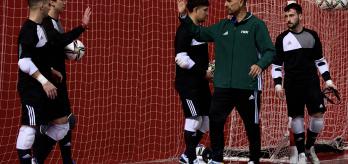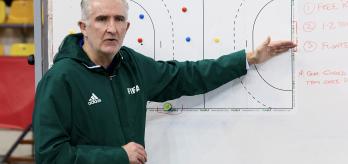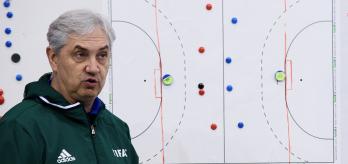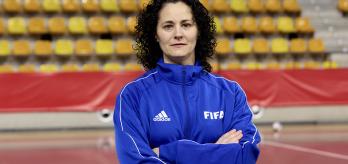Organisation
-
Use a full court.
-
Divide the court into three zones (as indicated in the graphic above).
-
Place a goalkeeper in each goal, a goalkeeper on the halfway line and an off-court goalkeeper on the touchline with a ball.
-
Position a pivot in each of the attacking zones.
-
Place 2 attackers off the court and on opposite touchlines in each half, level with the 10m line.
Explanation
-
The exercise starts with the off-court goalkeeper playing a pass to a goalkeeper defending one of the goals.
-
The goalkeeper plays an aerial ball to the pivot positioned in the opposite attacking zone, who controls the ball and finishes on goal or can finish first-time by redirecting the goalkeeper’s pass.
-
The goalkeeper positioned on the halfway line tries to intercept the goalkeeper’s aerial pass.
-
If the goalkeeper defending the goal catches the ball, they can either shoot directly on the opposition’s goal or play a pass to the pivot in the opposite attacking zone, who engages the goalkeeper in a 1v1 situation.
-
To add an extra level of difficulty for the goalkeeper who played the original aerial pass when they drop back into goal, they must touch the blue cone, which is positioned approximately 15m from goal, before being able to defend their goal.
-
If the goalkeeper is unable to claim the ball and diverts it out of play, one of the attackers positioned on the touchline dribbles a second ball into play to create a 2v1 scenario. This player can either shoot on goal or play a pass to the pivot, who takes up a position at the far post.
Variation
-
If the goalkeeper diverts the ball out of play, the pivot acts as a defender, creating a 2v1 overload in favour of the attacking team.
Coaching points
-
To offer the goalkeeper exposure to a range of finishing actions, ask the attackers who enter from the touchline to stay wide.
-
When the opposition restart play, the keeper should take the type of restart (if played with the hands or feet) into account in deciding how far to come off their line.































